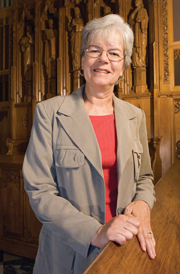The Fall and Rise of Religion
A new research project looks at spirituality in everyday America

What role does religion play in the day-to-day lives of Americans? By some measures, it’s significant; by others, it’s not. Researchers often assume that we fit neatly into one category or another — for instance, we’re either churchgoers or we aren’t. But what’s really going on is not nearly so clear, says Nancy Ammerman, a professor of the sociology of religion in the College of Arts and Sciences and the School of Theology.
“I think there are a fair number of people who are quite unconvinced by the culture wars,” Ammerman says, “and I’m anxious to describe what the middle ground looks like, not the extremes.”
So she and a group of colleagues are starting a research project she hopes will represent the varieties of religious experience in America and how religion influences people’s everyday lives, mostly in that middle ground. Funded by a grant from the Templeton Foundation, her project, Spiritual Narratives in Everyday Life, will study in depth religion’s influence on the lives of 100 people, divided between Boston and Atlanta. All the subjects will tell the stories of their lives, including their work lives, and discuss how religion plays a role — or doesn’t.
“There’s a presumption that we’re living in a secular culture and that religion is declining in importance,” Ammerman says. “I’m not so sure that is true.” At the same time, others believe the country is becoming increasingly religious.
Ammerman, who has written extensively on American religious congregations, is the project’s principal investigator, joined by graduate students in the sociology department, who will do the Boston fieldwork, and another team based at Emory University, who will work in Atlanta. They will interview members of mainline Protestant, conservative Protestant, African-American Protestant, and Jewish congregations, Roman Catholic parishes, and a less mainstream religious congregation, as well as people who participate in no religious institution.
The subjects will be interviewed by field-workers and will record daily guided “oral diaries” and photograph objects with significant personal meaning. Follow-up interviews will determine the extent to which there are religious connections with those objects, in an attempt to gain further insight into the reach of religiosity in the subjects’ daily lives.
A report will be issued in two years discussing the findings and including excerpts from the narratives. Ammerman hopes that along with interesting data, the study will contribute a new, more nuanced way of studying the sociology of religion.
And she sees additional benefits. “I’m hoping it provides a way for people to imagine and talk about the presence of religion and spiritual things in everyday places, in nonthreatening ways,” she says. “I think we have a kind of cultural assumption that this is one of those things you don’t bring up in polite conversation, that it will just lead to fights. So I really do hope that by presenting an array of stories about how religion is and isn’t a part of the way people live their everyday lives, people will be able to imagine that maybe the person who says the word ‘God’ isn’t so fearsome, and maybe we can have a conversation with each other.”